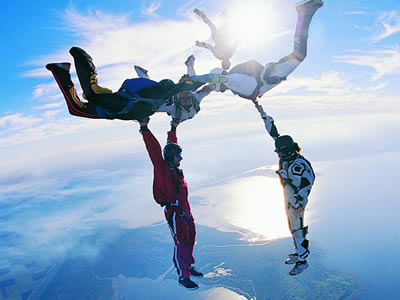Difference between Skydiving and Bungee Jumping
Key difference: Both, Skydiving and Bungee Jumping are thrilling sports. Statistically it is found that, Bungee Jumping is more dangerous and risky than Skydiving. In skydiving the acrobatics are performed, while in Bungee Jumping the stunts are not performed.
Skydiving (also called as Parachuting) is a recreational or competitive sport. The French aeronaut Andre Jacques Garnerin in 1797, mark the beginning of skydiving. Nowadays, the modern skydiving’s are performed from a propeller-driven airplane.

Skydiving is basically performed in two ways: individually and in groups. It is an exhilarating and terrifying sport, which involves jumping from an aircraft and free falling or parachuting back to earth. The parachute used in skydiving slows the descent and allows the skydiver to land gently on earth. It is performed as an assortment of aerial maneuvers and stunts, like the acrobatics before deploying from a parachute. The jump heights in skydiving range from 3000 to 15,000 feet. Different skydiving centers, offer different levels of jumps, as numerous companies around the world offer the opportunities for skydiving. Skydiving is carried out in two main actions, which comprises of the actual freefall and the canopy flight phase. The actual free fall can be of long or short duration, which ends when a pilot chute deploys and pulls the parachute out from the container. Once the parachute is pulled out, the freefall finishes and the canopy flight phase begins, which ends with the landing. It is found that the skydivers regularly check their gear to ensure its good shape, and many of them also carry a backup parachute. Sometimes, it is also found that the backup deploys automatically when a skydiver reaches a certain altitude. Hence, both the primary and backup parachutes have to be controlled with the steering lines, allowing the skydiver to control his/her descent.
Skydiving is dependent on important safety criteria such as:
- The perfect and exact location selection,
- The health factors, which includes the heart or lung conditions, high blood pressure, diabetes, and certain neurological disorders such as seizures or epilepsy and
- The price factor
In skydiving, the Lander should be able to select the exact location for landing. Other important factors are the right time of deploying the parachute, the post deployment of the parachute, and the landing. The skydiving jump runs have predetermined landing patterns in order to ensure the divers’ safety. In Skydiving, many people jump in groups, so they have to be with their groups and follow the lead of the First Lander.
Bungee Jumping (also spelt “Bungy” jumping) is a sport of leaping off tall structures while connected to a thick rubber band. First modern bungee jump was made on 1st April 1979, from the 250-foot (76 m) Clifton Suspension Bridge in Bristol, by the members of the Oxford University Dangerous Sports Club.
 In Bungee Jumping, people jump from a higher ground, such as a bridge. They have a rope tied around them to stop them from hitting the ground. The tall structure is usually a fixed object, such as a building, bridge or a crane; but it is also possible to jump from a movable object, such as a hot-air-balloon or helicopter, which has the ability to hover above the ground. It is considered to be an extreme sport full of thrill and excitement. The thrill comes from the free-falling and the rebound. When the person jumps, the cord stretches and the jumper is pulled backward. As the cord recoils again, it continues to oscillate up and down until all the kinetic energy is dissipated. It is one of the most dangerous sports. The equipment and their proper usage play a vital role in bungee jumping. The equipment like professional quality bungee cords, harnesses, carabineers and shackles are highly specialized in nature, so they are supposed to be purchased from a renowned and trusted place. The concept of kinetic energy is involved in the physics of Bungee Jumping.
In Bungee Jumping, people jump from a higher ground, such as a bridge. They have a rope tied around them to stop them from hitting the ground. The tall structure is usually a fixed object, such as a building, bridge or a crane; but it is also possible to jump from a movable object, such as a hot-air-balloon or helicopter, which has the ability to hover above the ground. It is considered to be an extreme sport full of thrill and excitement. The thrill comes from the free-falling and the rebound. When the person jumps, the cord stretches and the jumper is pulled backward. As the cord recoils again, it continues to oscillate up and down until all the kinetic energy is dissipated. It is one of the most dangerous sports. The equipment and their proper usage play a vital role in bungee jumping. The equipment like professional quality bungee cords, harnesses, carabineers and shackles are highly specialized in nature, so they are supposed to be purchased from a renowned and trusted place. The concept of kinetic energy is involved in the physics of Bungee Jumping.
The safety measurements in Bungee Jumping are of utmost importance, they include:
- The purchasing of quality equipment
- The jump at the safer location
- Examining the equipment before conducting the jump
- The bungee jumping is supposed to be learned from an experienced trainer.
Bungee jumping is considered to be the most dangerous type of sport. The injuries caused in bungee jumping, may be divided into: the injury occurred after the secondary jump, equipment mishap tragic accident, and those which occur due to the carelessness of the safety measures. In the first instance, the injury occurs due to the harness failure, miscalculation of the cord elasticity and the improper connection of the cord at the time of jump. Injuries that occur despite of the safety measures, generally relate to the abrupt rise in upper body intravascular pressure during the bungee cord recoil. Eyesight damage is the most frequently reported complication in Bungee Jumping.
Comparison between Skydiving and Bungee Jumping:
|
|
Skydiving |
Bungee Jumping |
|
Short description |
Skydiving is the practice of performing acrobatic movements during the freefall phase of a parachute jump. |
Bungee Jumping is a sport of leaping from the bridge, crane, or other high place, while secured by a long nylon-cased rubber band around the ankles. |
|
About |
It’s all about being in the sky and performing the stunts like the acrobatics. |
It’s all about taking the step off the platform and start falling. |
|
Performed from |
Skydiving is performed from the aircrafts. |
Bungee jumping is performed from the fixed object, such as the building, bridge or a crane. It is also possible to jump from a movable object, such as the hot-air-balloon or helicopter. |
|
Stunts |
Here the stunts are performed. |
Here the stunts are not performed. |
|
Types |
The types of skydiving’s are:
|
The types of Bungee Jumping are:
|
|
Disciplines |
The disciplines followed in Skydiving are:
|
The disciplines here have to be maintained by the individual, by following the instructions of the experienced trainer in order to conduct a safe jump. |
|
Parachute requirement. |
The parachute is required here. |
The parachute is not required here. |
|
Adventure |
Here, the real adventure begins after the jump. |
Here the adventure itself is performing the jump. |
|
Risks |
In skydiving, the risks occur only if the equipment malfunctions. |
In bungee jumping, risk occurs from the sudden, jerking stop of the bungee cord. |
Image Courtesy: ifullscreen.com, dreamtraveltrip.com









Add new comment